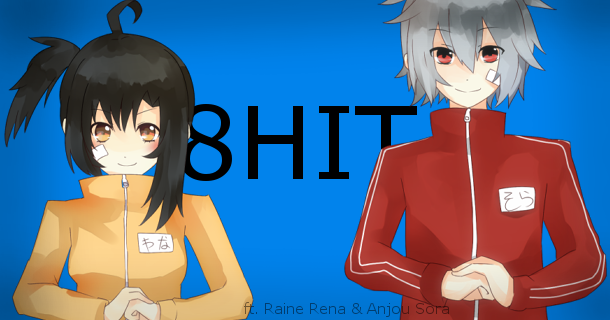So, a lot of people have asked me how I make my USTs... so I made this.
This is my first time writing a tutorial, so sorry if it's not clear or kind of bad...
It's a long tutorial... be prepared.
EVERYTHING WRITTEN IN THIS TUTORIAL IS MY
OPINION. IT MAY NOT BE 100% TRUE.
Alright, first off I'd like to say that this method of making a UST is
not the ONLY way to make an UST. There are probably a number of other ways to make an UST, but this is how I make mine.
But hopefully this tutorial will help you or teach you something new.
Warning: This method requires you to kind of...
not be tone deaf... because we'll be figuring out notes by ear. Oh, and probably have a decent sense of rhythm too.
Of course, being musically trained will help quite a lot. Knowing some music theory can be helpful but it's not mandatory. I find knowing a bit of harmony is helpful with making harmonies, though.
Oh, and have fun reading a wall of text.
I would say it takes me a few hours (4~6 hours?) to make one UST from
scratch depending on the difficulty. Obviously, a song with more people
will take longer.
It can get kind of tedious, especially with songs that repeat a lot (unless can you copy and paste it AHAHA), so be patient while working on it.
Also, sorry for the extremely unattractive pictures... I did them on Paint.
ALRIGHT, let's get started, shall we?
I will be using
Ikasama⇔Casino as a demonstration throughout this tutorial.
What we are doing in one sentence:
We are going to be making a MIDI, importing it into UTAU and then editing it to create a UST.
Programs Used (all are free):
*
Audacity (finding tempo, listening to the original song, etc.)
*
3ML Editor 2 [aka: 3MLE] (making the MIDI)
*
UTAU (kind of obvious what it's for)
*Optional: Adobe Audition (not free)
I
highly recommend you use a different program for making the MIDI because 3MLE is supposed to be used as a composing tool for a game called Mabinogi, but it exports MIDIs and I was already familiar with it... so it works for me. However, for beginners... you probably shouldn't use 3MLE.
I have heard of
Anvil Studio to make MIDIs but
I do not use it so don't ask me anything about how to use this program.
I also know some people use
FL Studio to make the MIDIs. (This is program is not free.)
Unfortunately with 3MLE, you'll need to learn
MML (Music Macro Language) to be able to do anything in this program.
I'll write a short guide on using 3MLE and MML at the end of this tutorial.
PART 1: THE MIDI
> Open up Audacity.
> Open up the song you will be making a UST for.
1. Tempo
The first step is to determine the tempo.
To be honest, I don't use some program or some fancy trick to find the tempo, I just keep guessing until I get it right... ehehe... however, doing that requires you to have a sense of timing and rhythm.
If you don't have a sense of rhythm, you can use a tempo/bpm finder program. Thanks to Katya Malyavina for recommending
this program.
Go to Tracks > Add New > Audio Track
With the new track selected, click Generate > Click Track
A window should appear.
*Click image to view full size
(I already know the tempo is 204)
If you're guessing the tempo (like I usually do), for now, just put in some tempo you think might work.
> Click OK to create your Click Track
> Zoom into the beginning of the song
> Align the first beat with the first beat of the song.
> Now listen to it. If your tempo is off, re-do these steps until you guessed the correct tempo.
> Once you got the correct tempo, listen to the whole song and
watch out for things that can happen listed below.
Special Cases:
*
Some songs have pickups, meaning that the first sound of the song may not necessarily be the first beat. You can tell if you listen to the whole song and the tempo is correct, but the strong beats seem to be off. Just drag it so that the first beats are where the strong beats are. (This is pretty common in songs actually). (ie. First Love Academy, School of True Love - first 3 notes are a pickup, 4th note is beat 1).
*
Some songs have a completely different tempo during the intro before the singing or the instrumental beginning doesn't align with the rest of the song. If that is the case, just drag the start of the click track to the first beat of the singing or the normal part and work from there.
*
Some songs change tempo a lot. Make sure you can determine when it does and follow it accordingly. You MAY have to split your UST into parts, but MAJOR PROPS if you don't. (ie. Astral Domination/Endroll A)
*
Some songs have fermatas (meaning long held notes, but I'm talking about ones that DON'T stick to the tempo). If you see these in the song, it probably killed your tempo big time. You MAY have to split your UST into parts, but MAJOR PROPS if you don't. (ie. Amayumerou, Life Prolonging Treatment)
*
3/4 songs or songs with 3 beats per bar. I don't believe 3MLE allows you to view in 3/4 time, so it's best to just use 4/4 for these songs if you're using 3MLE. If you're using another program that can view in 3/4 time, go ahead and do that.
btw, Ikasama Casino doesn't have any of these problems c:
Now that you've got your tempo done, set your tempo on the MIDI program, and it's time to determine the first note.
2. Determining the Notes
This is the harder part. Hopefully you have a good ear because otherwise I can't really give you many tricks.
I'd say that the first note is the
MOST important note to
NOT GET WRONG because if you have the first note wrong, you might follow with more wrong notes and throw off the whole key (though, I think you'll catch that your key is off because it should sound completely horrid and wrong in comparison to the original).
> Go to the first note of the song.
> Determine which beat the first note is on.
I like to have the start of my MIDIs/USTs at the beginning of the bar where the singing starts. So, I ignore the introduction, and Bar 0 (the first bar) is the bar where the singing starts.
A tip to determine the first note correctly is to
sing and hold it, then press on a keyboard to find a pitch that matches. This trick doesn't just work for the first note, but any note(s) you aren't sure about.
3MLE comes with a piano roll on the left where the keys are clickable.
After you have the first note, you should be able to determine the notes after it if you know the song well.
I keep on pressing the notes on the piano roll to find them.
As for determining the note lengths, this is where the click track comes in handy. Each click in the click track should be spaced by quarter notes. With that in mind, it can really help with figuring out note lengths.
However, it's fastest to just go by what lengths sound right to you if your sense of rhythm isn't all over the place.
Just keep in mind: It's
very unlikely to have weird lengths of notes. Your notes should really only be whole, half, quarter, eighth or 16th notes. Anything smaller than that is abnormal and probably NOT right (though on some rare occasions, it happens, ie: when the lyrics end in consonants.)
Another tip: you can work bar by bar or phrase by phrase. Play one
bar/phrase, memorize it, and figure out all the notes in that
bar/phrase. Replay to double-check, then move onto the next one.
One more tip: If you hear lyrics like "gen" on one note or something (totally just made that up), it might sound like one note, "gen", but you should split that note into two, "ge|n", so when you're inputting lyrics when making the UST, it'll be easier on you because you won't have to split the note there (it's more annoying to split stuff on UTAU, in my opinion).
As for many bars of rests in between the singing, I rely on the click track to tell me how many bars of rests there are.
*sorry for my extremely ugly quarter rest drawing... I drew it with a mouse on Paint.
If your song as more than one person singing: You're going to have to create another track and keep their notes separate.
3. Creating Harmonies
Method 1
**
This method requires you to know some stuff about music theory and harmony and have a good ear. Otherwise, it might just sound like a big block of gibberish or end in disaster.
This is the method I use all the time.
I find this method to work faster than method 2, if you know what you're doing.
Up until this point, the key didn't really matter too much as long as the melody notes were correct.
However, you may need to figure out the key of the song now to create harmonies more easily.
I'm just going to assume in this method that you know your key signatures.
Figure out your key and just make sure your harmony doesn't hit some note that's not in the key.
Finding the key isn't mandatory, but knowing it does make creating harmonies an easier job.
If you choose not to find the key, just
make sure you listen to the harmony you created and make sure it
sounds good and
not wrong or weird.
I listen to the original for harmonies and base my harmonies on that. Wherever I hear a harmony, I create one there. (Hopefully you can tell where there is or isn't a harmony by listening).
I don't actually copy the EXACT notes that the original uses, but I try to get close to it by listening to what kind of interval sound the harmony makes with the melody.
Most songs have the harmony sing notes below the melody, but some DO have harmonies above the melody. It's hard to explain what that sounds like, but if you can hear that the harmony is above the melody, it's most likely a 3rd above. If you can hear that well, I think you'll know if it's more than that (maybe even a 4th on some notes or a 6th).
Here's my
horrible, makes-no-sense, you-probably-disagree explanation of the kind of sound an interval makes:
3rd = normal sounding, most common
4th = a little more open sounding
5th = very hollow open, medieval sound. Avoid using just 5ths because that'll sound weird. Use sparingly or combine it with 4ths or 3rds to create an open sound (ie. like my Ikasama Casino UST).
6th = closer to normal sounding but can sound kind of funky sometimes.
7th = oh no (most of the time... if you're just creating 1 harmony. However, it can sound alright if you use it right; I have heard some producers use this in their harmony).
8th = very hollow open sound. One of the easiest intervals to hear.
And generally, as a rule of thumb, if your harmonies are regularly a 3rd under the melody, long notes at the end of a phrase should be a 4th to give a more finished sound.
So based on listening for these sounds, I kind of just make up my harmonies...
as long as it sounds good, right?
btw, by doing it this way, you can tell if someone's used your UST and they didn't credit (or, knock on wood, stole) your UST if your harmonies are unique. (Let's not forget pitchbends too).
Method 2
*
For those who don't have much knowledge about music theory & harmony or that great of an ear. Follows the song's original harmonies.
I don't usually use this method for a whole UST. I use this more for when I'm unsure of how a harmony starts. However, I don't believe this method works for all songs, but it does for some.
I learned this from
Doubie btw, when we were discussing about harmonies.
It doesn't require you to make up your own harmonies because you're listening to the one that's already in the song.
You can do this with both Adobe Audition or Audacity. (However, I think Adobe Audition works better. The harmonies are easier to hear).
Using Adobe Audition:
> Import the song you're making a UST for.
> On the left where "Effects Rack" is, click a triangle on one of the lines to open up a menu
> Go to "Stereo Imagery" > "Center Channel Extractor"
> From the Presets on the top, choose "Vocal Remove"
> On the bottom of the "Effects Rack" (bottom left), you can click on "Apply" to reduce playback lag.
Press space to play. Now you should hear the harmonies much louder.
You can also export it and open it back up onto Audacity if you prefer listening there.
Using Audacity:
> Import the song you're making a UST for.
> On the top left of the song track, click on the title.
> Click on "Split Stereo to Mono"
> Select the second (right channel) track (or either one, it doesn't really matter).
> Go to Effect > Invert
Now just do what you did for "2. Determining the Notes" except for harmony this time.
(btw, worked well for Ikasama Casino, and I found out my UST's harmonies are pretty different from the original XD
and it even works on my UTAU cover O_O uh, ok, enough playing around... moving on...)
4. Finishing up the MIDI
YES! You're finally done the MIDI!
but... not just yet.
Here's something you should probably do before exporting the MIDI -nod nod-
> Play the original song with your MIDI
at the same time.
Don't forget to adjust the volume so you can hear both and get your timing right (which can be a pain).
But it's worth it because you could possibly catch any errors or weird harmonies by doing this. (especially the weird harmonies because it might sound fine in the MIDI, but not with the off vocal).
(Also, for those using 3MLE, my 3MLE program plays faster than the actual tempo even though the tempo is correct. This is a glitch, so don't freak out if yours does that too.)
Once you think your MIDI is good, export it!
Now onto PART 2 ~
PART 2: CREATING THE UST
5. Importing the MIDI and Setting up the UST
This is what I do everytime I make a UST. You may do it differently; there is no "right" way.
> Open up UTAU
> File > Import > Find that MIDI
> Several Tracks should come up, choose one of them (I'll choose Len's main track - I generally choose the main parts first).
> Project > Project Property > Select the Voicebank you're using
> Select your resampler; type in your favourite flags (I always use F1Y0H0c99B0)
> Ctrl+A to select all the notes > Right-click > Region Properties (last option)
> Set modulation to 0.
> On the top, right-click the red tempo marking > Remove tempo marker
> Optional: on the top-left, double-click the tempo and retype the correct tempo (mine likes to glitch and display 50000).
> Save As... your UST.
> File > New
> File > Recent > Re-open your UST
> Optional: zoom in on the very beginning and delete that really tiny rest. (It always seems to be there, but
only for the first track of the MIDI).
> File > Save (
DO THIS OFTEN)
6. Working on the UST
I work by phrase by completely finishing everything in one phrase before moving onto the next.
Some of you might prefer to insert lyrics for the whole song, then tune the UST, but I'll be explaining how I do it.
I would look up the lyrics now, so,
> Go look up the lyrics (let's just say it's romaji, ok)
> Copy the first line/phrase
> Paste it in the "lyric" box on the top of the UTAU window
> It should look like this in the lyric box:
yokubo kenso kakehiki uzumaku andashiti
> You want to space each lyric individually like this:
yo ku bo ke n so ka ke hi ki u zu ma ku a n da shi ti
> Highlight the notes of the first phrase
> Click the first button to the right of the lyric box to insert the lyrics
* Make sure you inserted the correct lyrics on the right notes and watch out for notes that may have sounded like one note but had two syllables to it (such as "an" is actually "a-n" which is two syllables)
A LA CARTE
*Note: The purpose of using A LA CARTE here is to connect the vowels. If
you like automating your vibrato or portamentos, you can do it here as
well.
(The phrase should still be highlighted)
> Now go to Tools > Built-in Tools > A LA CARTE(M)...
> Check "Connect vowels smoothly to previous note!" Since it's romaji, in the "other" box, type "a e i o u". You can have either Tightly, Medium, or Slightly depending on your preference, but I usually just do Medium.
> Uncheck "Rising Note"
> Uncheck "Falling Note"
> Uncheck "Add Vibrato!"
> Click "Inside Region"
Now we have to do "n" seperately because if you do all the vowels + n together, syllables such as "na ne ni no nu" will also get affected, which we don't want. (If you're using hiragana, you don't have to worry about this).
> If you have any "n" in your phrase, highlight only that "n"
> Go back to Tools > Built-in Tools > A LA CARTE
> In "Others", add "n"
> Click "Inside Region"
> Repeat this step for any other "n" in your phrase
7. Tuning the UST (adding pitchbends, vibrato, etc.)
I listen to the original and copy any pitchbends I hear. Some UST makers may do whatever sounds good to them. It's all your preference and up to you. Some prefer sounding closer to the original, and some prefer doing their own thing or "enhancing" it.
So, I don't think there's much I can say about this...
(If you have any questions on how to do SPECIFIC things related to this, please contact me, but take a look at the FAQ first before asking).
Here's how my first phrase looks after adding some pitchbends:
Just repeat 6 and 7 for the rest of the UST for every phrase...
Tip: If you notice that the song repeats a phrase/section, you can copy and paste that phrase/section again, but be careful when doing this and avoid screwing up the timing.
Congrats! You're done the main melody UST now ^^
8. Working on the Harmony UST
There are two ways that I make my harmony USTs depending on how I feel/the song.
Method 1 is using the harmony MIDI and doing things from scratch (with reference to your main UST).
Method 2 uses the original main melody UST and just dragging the notes to match harmony notes.
I generally use Method 1 unless the main UST has A LOT of pitchbends that I don't want to re-do again.
Method 1
> Have the main melody open as reference.
> Repeat Step 5 of importing the harmony track and setting up the UST. (Don't forget to
SAVE).
> Copy the lyrics from the main UST.
> Apply A LA CARTE to connect vowels (like in Step 6)
> If you want to (not mandatory), copy the pitchbends of the main UST as well.
Method 2
> Have the completed main melody open.
>
SAVE THE MAIN UST AS A HARMONY UST FILE. (be careful
not to lose or save over your original main UST)
> Open another UTAU window & import the harmony track from the MIDI as reference.
> Start dragging the 1st harmony file's notes to match the reference harmony's notes.
* You may have to insert rests (R) on notes that don't have harmony.
*This way, you keep the envelopes, pitchbends, etc. of the main UST in your harmony UST.
* MAKE SURE YOU RENDER BOTH MAIN+HARMONY .WAVS AND PLAY THEM TOGETHER TO MAKE SURE YOU DRAGGED ALL THE HARMONY NOTES TO THEIR RIGHT PLACES.
YAY! You're done your UST! 8'D
You can go mix your song now! WOOOO
Hope my tutorial helped ~ (though it kind of heavily relies on you having a good ear .___." and it's just one big block of text...)
I hope you at least learned something new ^^"
If you have any questions, contact me and I may put it in the FAQ on the bottom.


 06:39
06:39
 Kream
Kream
 06:37
06:37
 Kream
Kream
 08:10
08:10
 Kream
Kream
 08:06
08:06
 Kream
Kream
 08:00
08:00
 Kream
Kream
 07:50
07:50
 Kream
Kream
 07:44
07:44
 Kream
Kream
 13:22
13:22
 Kream
Kream
 07:39
07:39
 Kream
Kream
 12:43
12:43
 Kream
Kream
 12:27
12:27
 Kream
Kream
 12:26
12:26
 Kream
Kream
 12:24
12:24
 Kream
Kream





